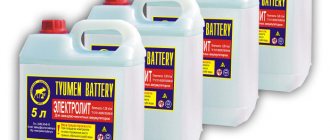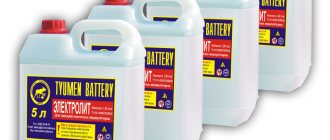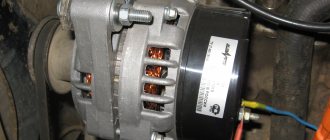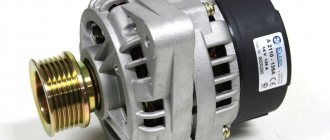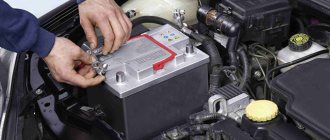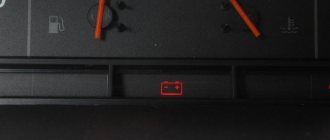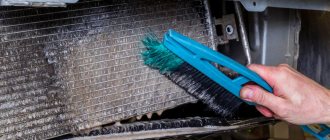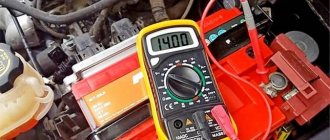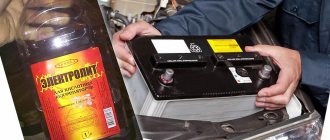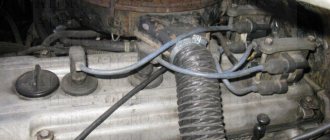How do the properties of electrolyte change in a vehicle battery?
Many professionals consider the question of what to put in the battery to be absolutely incorrect, since the device is classified as a non-repairable element. However, a good battery is far from a cheap pleasure, so the desire of car owners to extend its service life is understandable. To ensure that refilling the battery does not lead to its complete failure, you first need to understand the processes that occur during the operation of the battery during its systematic charging and discharging.
Initially, from the factory, the battery contains an emulsion, which consists of thirty-five percent sulfuric acid, while the remaining sixty-five percent of the volume is distillate - purified water, without impurities. During operation, the device heats up, an electrolysis reaction occurs, and part of the water evaporates under the influence of high temperature and collects as condensate on the inner surface of the unit. If the battery has a completely sealed design and there is no mechanical damage in the case, then when it cools, the steam turns into water and flows back down the walls of the device.
If there is damage to the case as a result of operation of the device or due to poor manufacturing quality of the product, the water evaporates from the battery irretrievably. As a result of this process, the liquid in the battery becomes more concentrated, and the density of the acid increases. This is reflected in the voltage output criteria of the device and its performance.
In addition to the natural process of evaporation at operating temperatures, the so-called sulfation reaction occurs in the battery - the deposition of acid salts on the lead strips of the battery. As a result of this process, the electrolyte concentration decreases. Precedents when the density of the electrolyte drops are most often provoked by irregular functioning of the battery as a result of prolonged downtime of the car or incorrect operation of the battery - supplying too much current to the device or serious malfunctions in the vehicle electronics.
Water or electrolyte: which liquid to choose?
The first rule when carrying out any repair or maintenance work on functioning vehicle devices is to do no harm. In the case of battery maintenance, adding the “wrong” fluid can completely damage it. From the information described above, it is clear that a decrease in the efficiency of the battery can be both a result of sulfation - a decrease in the acid coefficient in the unit, and a consequence of water evaporation. Before deciding whether to fill it with water or electrolyte, it is important to first understand the reasons that affected the performance of the battery.
If the reason is a decrease in the percentage of acid in the fluid in the battery, then it is the electrolyte that needs to be poured into the device. When filling with distillate, the percentage of acid in the battery will decrease even more, which will make further use of the charger impossible. In a situation where the cause of the unit malfunction was the evaporation of distilled water, filling the battery with alkaline liquid will provoke a proportional increase in acid in the device, which will lead to intense sulfation.
Acidic components will settle on the plates, destroying them, which will result in the irreversible unsuitability for use of the charging element. In this case, distillate is poured in - this is the only way to extend the life of the battery.
How to recharge the battery?
Before you start deciding whether to add water or electrolyte to the battery, it is important to decide whether the mechanism needs to be refilled at all. For this purpose, you need to carefully inspect your existing unit. Mostly, the housing of all batteries is made of transparent plastic, which allows you to visually determine the amount of electrolytic solution inside. There are almost always marks on the battery case, by which you can determine whether the emulsion needs to be topped up or not.
If the housing is made of opaque material, you can check the emulsion level in the following way:
- Unscrew the battery cap. Thoroughly clean the front surface of the unit first so that when opening it, no dirt particles get into the system.
- Take a transparent tube with a diameter of no more than five millimeters and lower it all the way into the opening.
- Close the outer end of the tube tightly with your finger and pull the device out of the system without releasing your finger.
- The criteria are considered normal when the height of the liquid in the elongated tube is approximately one and a half centimeters. If the parameters do not match, it is necessary to top up or remove excess liquid.
If the need for topping up has been established, then you need to decide what needs to be added to the battery. A special device called a “hydrometer”, which can be used to measure the density of the solution in the battery, can help in this situation. Based on the test results, the cause of the mechanism malfunction is determined, and the dilemma of whether to add water or electrolyte to the battery is resolved.
Using the device, measure the density of the battery fluid: normally it should be from 1.27 to 1.29 grams per cubic centimeter. If the density is significantly lower, then an electrolyte will need to be added. A density exceeding 1.29 units indicates that water must be added to the battery.
The procedure for adding water and electrolyte is carried out according to a similar scheme:
- If the case is transparent, add the required fluid to the level marked on the battery itself using a bulb or syringe. Otherwise, add liquid in portions, systematically checking its level using a transparent tube according to the algorithm described above.
- After adding liquid, tighten the cap and shake the battery well so that the solution is thoroughly mixed in the system. Check the density again. If the result does not correspond to the norm, remove part of the emulsion using a syringe and add the required liquid again. Re-check the resulting solution.
- When the indicators have reached normal parameters, leave the unit to stand for several hours, you can put it on gentle charging during this time so that the liquid mixes as well as possible and acquires a uniform consistency. After the specified time has elapsed, carry out a control check of the density of the solution in the battery. Normal indicators indicate the correctness of the procedures performed and the possibility of further operation of the battery.
When performing the procedure for “resurrecting” the battery, remember that incorrect work performed can not only lead to a complete malfunction of the unit, but also lead to problems with car electronics. Check the odometer readings very carefully and you will succeed. If you need to fill the distillate, never fill it with regular tap water - it contains a lot of additives that will negatively affect the functioning and service life of the battery.
Let's sum it up
Extending the life of mechanisms and systems that are directly involved in the functioning of the vehicle is the desire of every car owner, since the purchase of any mechanism or accessory is an additional financial waste. In the case of a battery, experts and professionals strongly recommend not to experiment, especially if the existing device belongs to the category of budget products; if it fails, they advise buying a new battery. Attempts to restore the functioning of the battery by refilling it will only temporarily extend the operating life of the unit, so purchasing a new charger is inevitable. It’s better to immediately purchase a high-quality battery for your car, which, if used properly, will serve you for many years.
Maintenance October 5, 2019 To power the on-board network of vehicles, lead-acid batteries with a liquid or thick electrolytic composition are used. Owners of used cars are faced with questions: is it possible to add electrolyte to the battery and how to correctly perform the procedure. Adding liquid allows you to restore capacity and extend the life of the DC source.
How do the properties of the electrolyte in a vehicle battery change?
To fill the battery, a mixture of distilled water and sulfuric acid is used. During the course of electrochemical reactions, water decomposes and evaporates, vapors condense on the inner walls of the case or escape into the atmosphere through ventilation holes. The volume fraction of acid in the solution increases, which, together with the low level of liquid in the jars, negatively affects the capacity and service life of the battery.
At the final stage of battery charging, oxygen is released at the positive electrodes, which can be restored at the negative element. But due to the presence of liquid, the process slows down, which leads to the release of gas from the battery and a drop in the electrolyte level. The use of sealed cases has reduced the evaporation rate, but during discharge, lead sulfate is formed on the surface of the plates, which does not decompose during the charging of the power source. Because of this, there is a drop in the density of the electrolyte, which negatively affects the battery capacity.
The lead used to make electrodes reacts with water molecules. As a result, the density of the electrolyte changes, and foreign impurities appear in the solution, worsening the performance characteristics of the direct current source.
To eliminate the negative effect, alloying additives are introduced into the alloy composition to reduce the corrosion rate.
Drain the electrolyte and wash the battery
If it is necessary to replace the electrolytic solution, it means that irreversible processes have begun in the banks - the appearance of sediment, a decrease in the density of the electrolyte, sulfation, and destructuring of the lead electrodes. All this leads to the appearance of foreign impurities in the compartments. Therefore, work begins with draining the liquid and washing the battery. If you don’t know how to do this correctly, use our instructions.
- Charge the battery for 2-3 hours with minimal current.
- Disconnect the charger and allow the electrolyte to cool.
- Carefully turn the battery over and drain the fluid.
- Using a douche or syringe, fill each jar with distilled water, then drain. Repeat the operation until the water becomes clear.
- Make a soda solution (a tablespoon of soda per 1 liter of distillate).
- Pour the prepared liquid into jars, wait 3 hours, and then drain.
- Make a saline solution according to the same recipe, fill the compartments with it and connect the charger for 1 hour.
- Drain the liquid and rinse the jars again with distilled water.
- Now fill in the soda solution and connect the charger for 2-3 hours.
- Drain the liquid and wash the compartments.
Don't be intimidated by such a complex method. Consistently washing the jars with different solutions will remove all foreign impurities. If you do not do such operations, you will have to drill holes at the bottom of the case to completely clean the compartments. In this case, the tightness of the battery will be compromised, which is not always possible to properly restore.
To rinse the battery thoroughly, we recommend using a syringe or syringe without a needle to pump out the liquid. This way you will be sure that there is no old electrolyte or impurities left.
Ways to check fluid level
The amount of solution is checked using control marks applied to the internal or external surfaces of the housing. Some batteries have a viewing window made of transparent material. The manufacturer applies marks corresponding to the maximum and minimum fluid levels. Under normal operating conditions, the level is between the notches; It is prohibited to operate the device with increased or decreased volumes of liquid.
If the power supply housing is made of opaque plastic, then inspection windows closed with screw plugs are used to check the degree of filling of the cans. Before unscrewing the plugs, dust and dirt are removed from the surface of the housing. For testing, a glass tube is used, which is lowered into the cavity of the jar until it touches the electrodes. The opposite end is clamped with a finger, which allows you to hold the solution inside the tube.
Instead of a glass element, a folded sheet of paper can be used, which is lowered into the electrolyte until it touches the plates.
The owner can determine the electrolyte level by visual inspection, but the technique does not provide high measurement accuracy. The volume of liquid in the jars should be the same (5-15 mm above the top edge of the electrode package); If the level drops, distilled water must be added. In maintenance-free devices equipped with a sealed housing with a ventilation labyrinth, checking the electrolyte level is not provided. The car owner can check the volume of liquid only after drilling holes in the lids of the cans.
Car battery maintenance schedule
It is necessary to distinguish between diagnostic procedures and battery maintenance itself, although both types of maintenance are aimed at maintaining the battery in working condition.
Diagnostics of a car battery includes the following operations:
- checking the voltage at the terminals without load (with the wires disconnected);
- monitoring the voltage level in the on-board network when the power unit is running;
- visual assessment of battery condition;
- periodically checking the electrolyte level.
Performing these procedures in a timely manner will prevent many common battery problems from occurring.
Now let’s list what operations are included in periodic battery maintenance:
- charging the battery with an external charger (scheduled and as needed);
- battery test using a load plug;
- checking the density of the acid solution and adjusting this indicator;
- leakage current control;
- desulfation of plates.
To carry out the above work, the car owner must have the following materials and tools in his arsenal:
- multimeter;
- automobile hydrometer;
- load fork;
- Charger;
- bulb for pumping out electrolyte;
- hollow transparent tube;
- electrolyte;
- distilled water.
Most battery maintenance work requires the use of protective equipment (rubber gloves, safety glasses) to avoid contact with exposed skin and eyes with chemically aggressive electrolyte.
In what cases should electrolyte be added to the battery?
When carrying out restoration measures, it is important not to cause additional damage to the battery. Incorrectly adding electrolyte or water can further disrupt the electrochemical balance and will ultimately destroy the battery. For example, when sulfating plates, acid is consumed from the solution; To replenish the volume, refilling with clean electrolyte is required. When water naturally evaporates, distillate must be poured into jars, since the introduction of additional sulfuric acid will cause accelerated sulfation.
The need to replenish the fluid supply in the battery is determined by the results of level measurement. Topping up pure electrolyte is possible if the owner knows exactly the volume of the lost substance. Otherwise, it is necessary to measure the density of the solution, which allows maintaining the optimal concentration of sulfuric acid.
Should I add water or electrolyte to the battery?
To determine the substance that needs to be added to the battery banks, it is necessary to measure the density of the electrolyte using a hydrometer. The device is a glass tube with a measuring scale, inside of which there is a float. Under normal conditions, the density of the solution ranges from 1.27 to 1.20 g/cm³. A deviation of the parameter downward indicates a lack of sulfuric acid, and a greater deviation indicates the need to add distilled water.
Density measurement algorithm:
- Charge the battery using an external automatic device.
- Disconnect the device from charging and pause for 3-5 hours. To increase the accuracy of the results, it is recommended to take measurements at a temperature of 25°C.
- Wipe the battery cover from dirt, and then unscrew the plugs. If the product is equipped with a blind lid, then holes must be drilled to measure the density.
- Place the rubber bulb on the glass body of the hydrometer and fill the cavity with electrolyte 2-3 times (to increase the measurement accuracy). Check the density in the battery banks one by one. It is not recommended to put a large amount of electrolyte into the reservoir, since excess liquid prevents the free movement of the float.
Features of caring for serviced batteries
Maintenance includes the following procedures:
- Assessment of the degree of fastening reliability. If necessary, bolts and nuts are fixed.
- Terminals and clamps are cleaned of oxides and rust. To prevent the formation of corrosion, parts are treated with lubricants.
- Visual and instrumental check of the level of electrolytic composition. For testing, improvised means and special tubes are used. When the electrolyte level decreases, the jars are filled with distilled water and the prepared electrolyte. You can buy them in stores.
- Determination of electrolyte density. The charge level also depends on this indicator. Excessively low readings indicate a poor charge.
- Checking battery performance using a load fork.
Filling with electrolyte is carried out only if there are smudges. This procedure includes a number of processes. The performance of the on-board system, main components and the car depends on the correctness of their implementation.
When to add electrolyte and when to add water?
Since sulfuric acid is not consumed from the solution during standard battery operation, distilled water is used to replenish the level. The volume of liquid in the cans is brought to a normal level, which is marked with special marks on the plastic case. It is not recommended to pour in excess liquid, as there is a risk of the solution being released into the engine compartment of the car. Pure electrolyte is used when replacing working fluid in cans; the volume of solution required for refilling depends on the battery capacity.
How to add distilled water to a battery
If the density is higher than normal, this indicates evaporation of the liquid that needs to be added. How much water should I add to the battery? The level of the solution in the battery must be maintained 1-1.5 cm above the level of the plates. You cannot add distilled water more than the permitted amount. After refueling, be sure to re-check the density of the liquid by first charging the battery.
How to add electrolyte to a maintenance-free battery?
If the owner wants to add water or pour electrolyte into a maintenance-free battery, he will need to remove the lid of the cans or make holes in the upper part of the casing (the diagram depends on the design and manufacturer of the product). The channels are pierced with a sharp awl until they touch the lead electrodes. The technique allows you to determine the distance between the top edge of the cover and the lead plates. To ensure normal operation of the power source, the electrolyte level must be 10-15 mm above the top edge of the electrodes.
If the solution level is below the required value, then distilled water must be added. The liquid must be poured using a medical syringe or a rubber bulb with a capacity of 10-20 cm². The tool is equipped with a shortened needle; the length of the element allows you to control the level of liquid in the jars. The plastic base of the needle should not fall into the cavity of the jar through the hole.
The owner adds water by periodically reversing the piston or releasing the bulb body. If air is drawn into the cavity, filling continues.
After reaching the required level in all banks, it is recommended to shake the battery case, ensuring mixing of water and acid-containing solution. It is prohibited to shake the battery sharply or turn it on its side, as sludge will get between the electrodes. It is necessary to carry out a control measurement of the level: if there is little liquid in the jars, then it is necessary to introduce an additional portion of distilled water.
The holes are sealed with sealant, then the power source is charged. Please note that adding water allows you to temporarily restore battery parameters.
Complete replacement of electrolyte in the battery
To replace the electrolyte in the battery, you must perform the following steps:
- Place the car on a level surface. If the design has a standard radio, then you need to find the unlocking code (needed to restore the player's functionality when the power is connected).
- Remove the cables and unscrew the fastenings of the power source, and then wipe the case from dust and traces of electrolyte with a cloth moistened with an aqueous solution of ammonia.
- Unscrew the caps of the cans or drill holes in the lid.
- To drain the liquid, you need to attach an extension tip to a medical syringe or rubber bulb, and then pump the solution out of the jars. It is forbidden to turn the battery case over, since sludge particles accumulated in the lower part of the casing will short the plates and damage the battery.
- To drain the maximum volume of electrolyte, you need to tilt the body at an angle of up to 45°, the solution is pumped out with a syringe or bulb. To remove electrolyte residues, it is necessary to fill the jars several times with distilled water; To speed up the procedure, rocking the body from side to side is allowed. It should be taken into account that it is impossible to completely wash out the electrolyte - the remaining solution remains in the cavities between the electrode grids.
- Fill the jars with the prepared reagent: the liquid level should be above the top edge of the electrodes.
- Keep the device indoors for 5-6 hours, and then charge the power source and check the performance of the battery. It is recommended to charge the product with a current of no more than 0.1 A, which is supplied for 18-20 hours. To restore capacity, it is necessary to perform 2-3 cycles of charging and discharging with low current.
- Carry out final charging with a current of 10% of the battery's rated capacity. Charging is carried out until the voltage is fixed at the terminals at 14.6-14.7 V. It is recommended to check the density of the electrolyte: if the value increases above the standard, distilled water is introduced into the solution.
- Install the battery on the car and connect the cables.
It is not allowed to remove electrolyte through additional channels drilled in the bottom of the housing. When drilling holes, there is a risk of damage to the plates, which leads to short circuits. The battery case is made of special acid-resistant plastic that cannot be sealed or sealed. When draining a solution based on sulfuric acid, it is recommended to use protective gloves; the liquid must not be poured into the sewer.
Many car enthusiasts have encountered the following problem: the battery begins to discharge quickly even if there is no heavy load on it, for example, turning on the air conditioner in a traffic jam or playing loud music with the engine off.
It even gets to more serious situations - a half-charged battery turns out to be completely discharged the next day when you try to start the car. The car enthusiast takes the battery to charge, it is fully charged, but the next day the battery turns out to be half dead. What to do in such a situation? A new battery is quite expensive, but replacing it is not always necessary; sometimes it is enough to check the density of the battery and top up the electrolyte, thereby bringing the battery to normal operating condition.
However, many car enthusiasts have a question: is it possible to add electrolyte to a battery at low density or is it recommended to completely replace the battery? In this article we will analyze several situations, in which case it is best to do this, and also provide answers to other questions.
How to replace the electrolyte correctly?
A decrease in acid density is a common battery defect that occurs during machine operation. The main reasons for this are sulfation of the plates, aging or charging problems (overcharge/undercharge).
Let's take a closer look at the sulfation process. It occurs due to insufficient battery charge - lead oxide is reproduced inside the battery grids and the oxidation process begins. An increased percentage of lead sulfate leads to a decrease in the density of sulfuric acid, which is the basis of the electrolyte. Using a special device called a hydrometer, you need to measure the density and then increase it to the ideal value.
Here's how to replace the electrolyte in a car battery to avoid common mistakes:
- Density must be measured on a fully charged battery;
- the amount of liquid in the jars should be at least 20-30%;
- You cannot add electrolyte immediately after taking measurements on the car.
Ignoring these rules threatens to continue the sulfation process and destroy the battery.
Separately, I would like to draw attention to the following points:
- If the density of the electrolyte is within normal limits (1.27-1.29), the acid is simply added to the level.
- In case of too low density values, several useful cycles are performed to improve the charge. The battery is discharged and charged several times in a row. Then fresh electrolyte is added, ensuring the required level of liquid in the jars.
- If the density of the substance is excessively high, clean water is added to the battery. Usually enough liquid is added so that it covers the plates of the cans by 5-7 mm. The water must be distilled, otherwise a hydration reaction may occur.
An excessively high electrolyte level is unacceptable! There should be 2 cm of free space in the jars.
The need to urgently replace the acid in the battery can be judged entirely by the following signs:
- the color of the liquid is cloudy, changed;
- it is impossible to achieve the required density after recharging the battery;
- the new battery begins to discharge quickly;
- There is no liquid in one of the cans.
If the battery was carelessly left in severe frost for a long time, this is also a reason for replacement.
When should electrolyte be added to the battery?
It is common knowledge that the electrolyte in a car battery consists of acid and distilled water. These liquids are mixed in different proportions and there are still significantly fewer acids. As an example, you need to obtain an electrolyte with a density of 1.28 g/cm³, then for this you will need to add 0.36 liters of battery acid to 1 liter of distilled water. That is, the ratio should be somewhere around 1 to 3.
For safety reasons, it is worth adding that you need to pour the acid into the water and not vice versa. Since there is a high probability of a chemical “response” from this mixture with the release of heat and splashes. There is no need to talk about the consequences of getting sulfuric acid on the skin or eyes. The whole point is that water is lighter in structure than acid, which means that mixing of liquids will occur very slowly.
It is the ratio of acid and water that is shown by a hydrometer - a device designed to determine the density of the electrolyte in the battery. When the density of the electrolyte becomes excessively low, it begins to hold a charge poorly. If, when checking the density, its values turn out to be slightly less than the required 1.25-1.30 g/cm³, it is still recommended to add electrolyte rather than water.
It is worth noting that the density of the electrolyte changes depending on the state of charge of the battery. That is why accurate indicators of the density of battery fluid can only be obtained on a fully charged battery. In addition, it is best to charge the battery with a weak current over several days!
What affects the life of a car battery?
To properly maintain a car battery, you need to understand what factors affect its service life. Then it will be clear what you need to pay attention to first. Listed below are the main factors affecting battery life.
Charge level
If a car battery is often in a discharged state, this greatly reduces its service life. Ideally, the battery should be constantly charged. That is, when the engine starts, it gives up part of the charge, and with further charging from the generator during the trip, it makes up for these losses. But a modern car with a large number of current consumers simply does not have time to replenish the lost charge. This is not helped at all by the city driving mode with frequent engine starts and many hours of idling in traffic jams. Therefore, there is a need for periodic charging from a mains charger. If the battery is constantly in a discharged state, the service life of the car battery will be significantly reduced.
Operating temperature
The temperature at which the battery is operated is also a factor that affects its service life. The starting power of a car battery largely depends on temperature.
As you know, a fully charged battery produces its declared capacity at 15-20 degrees Celsius. When the temperature decreases by one degree, the battery capacity decreases by 1 Ah.
Frozen electrolyte in the battery
If the car is in the cold with a discharged battery, the electrolyte in the battery may simply freeze. This often ends in battery failure. Read more about this in the article “Frozen car battery: reasons and what to do.” In the hot season, problems may be associated with the evaporation of water from the electrolyte. If the electrolyte level drops significantly and the plates are exposed, then operation in this mode greatly reduces the battery life. Therefore, periodic diagnostics of the car battery and its maintenance are required.
Vehicle on-board network condition
This is an important point, since the condition of the battery greatly depends on the health of the car's electrical network. It is especially important to have a working generator and voltage regulator. If these components do not work properly, then even with regular maintenance of the car battery, it will wear out ahead of time.
Keep your car's electrical network in order
If too high a voltage is supplied to the battery in the on-board network, this will lead to its overcharging and constant “boiling”.
As a result, there will be a high water consumption and a drop in the electrolyte level. In addition, excessive charging will cause premature destruction of the electrodes. Read more in the material “The car battery is boiling: causes and solutions.” If the voltage in the network is less than normal, the battery will be constantly in a discharged state. The negative consequences of this were discussed above. So, a faulty car electrical system significantly reduces the service life of the battery.
Corrosion processes
Corrosive processes also reduce the service life of a car battery. Manufacturers combat this phenomenon with the help of various alloying additives. Corrosion is a natural process in all batteries. Motorists here can be advised to use high-quality electrolyte and distilled water when servicing the battery.
If these consumables are of poor quality, then you risk only aggravating the corrosion phenomena. Here we can recommend buying distilled water at a pharmacy, and not at auto stores. There you risk running into plain tap water.
Sulfation
Sulfation is the deposition of lead sulfate on the battery plates, which leads to a decrease in battery capacity. The process of sulfation, like corrosion, is natural when using and storing batteries. But with proper and regular maintenance of a car battery, the intensity of sulfation can be significantly reduced.
An example of plate sulfation
It will be useful to periodically carry out battery desulfation measures, which are described in the link provided.
What to do with a lower electrolyte density?
So, the problem is this: the battery has stopped holding a charge. Is it worth changing it? Is it possible to add electrolyte to the battery at low density, or can the battery’s performance not be restored? The answer to this question depends on the age of the battery and the hydrometer readings when tested.
If the battery is old enough (for example, it is about 4-5 years old), then its inability to hold a charge is primarily due not even to the density of the electrolyte, but to a violation of the integrity of the plates in the battery banks. In this case, even restoring the previous density indicators will not solve the problem. However, if the battery is relatively new, the problem can be solved by adding electrolyte. The only question is whether it is necessary to fill in the electrolyte?
The average electrolyte density in a “working” battery is approximately 1.25-1.30 g/cm³. Moreover, this value should be approximately the same for each battery bank with a deviation of no more than 0.01-0.03. If the density of the electrolyte is less than 1.25, but more than 1.20, most likely adding electrolyte will help solve the problem.
We also watch a video on how to properly increase the density of the electrolyte in a battery: We also recommend reading the article on how to extend the life of a car battery. This article describes the main reasons for a short battery life, how to extend it, and signs that your battery will soon stop working.
Checking battery health
The battery performance indicator can be assessed by the amount of current that the battery is capable of delivering in a fully charged state for a certain time at a set temperature.
The standards set the current value at the pole terminals; accordingly, this indicator should not fall below the norm.
You can evaluate the voltage level using a battery tester. With this test, there is no need to disconnect the battery from the vehicle. This test will be able to show how suitable the battery is for the car during its warranty period.
This test can be carried out once and repeated after 100% recharging of the battery.
